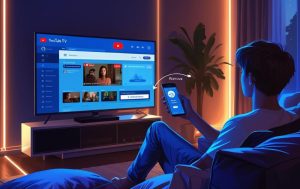
What is YouTube TV? A Complete Guide for Streamers
What is YouTube TV? A Complete Guide for Streamers Table of Contents Streaming television has completely changed the way we watch shows, sports, and news.
Can you use YouTube TV family sharing in different locations? Yes, but you must follow YouTube TV’s strict location policies.
Today, many families live in different cities, states, or even time zones. With the rise of streaming services, the idea of sharing one account across multiple homes is appealing. However, if you’re thinking about YouTube TV family sharing in different locations, there are rules you need to understand before setting up your family group.
This article explains how YouTube TV family sharing in different locations works, what the YouTube TV family group location rules are, and how to handle the location limits on YouTube TV. By the time you finish reading, you’ll have a clear plan to enjoy YouTube TV across households without breaking the rules or losing access.
If you’re also wondering how to cancel YouTube TV or pause it temporarily while traveling, it’s important to know your options.
YouTube TV family sharing in different locations is a feature that lets you share a single subscription with up to five additional family members. This allows each person to enjoy live TV, DVR storage, and personalized recommendations without needing separate accounts.
When you create a YouTube TV family group, you become the Family Manager. You set the YouTube TV family group location, which defines your home area. YouTube TV uses this home area to manage local channels and verify if your usage follows their terms.
Here’s what each family member gets with YouTube TV family sharing in different locations:
Even though YouTube TV family sharing in different locations is allowed, YouTube expects most of the usage to happen within one household. That’s why they place specific guidelines around the YouTube TV family group location and location limits on YouTube TV.
One of the most common questions people ask is: Can family use YouTube TV in different homes?
The answer is yes, but it comes with restrictions designed to prevent abuse. YouTube TV family sharing in different locations is permitted, but YouTube has implemented location policies to ensure that the service is primarily used within the same household.
Here’s how it works:
When managing YouTube TV family sharing in different locations, it’s important to remember that location limits on YouTube TV are part of their licensing agreements. They need to control access to regional sports and local channels.
So, while your family can enjoy YouTube TV family sharing in different locations, you still have to return to the home area regularly to keep access active.
If you’re planning to use YouTube TV family sharing in different locations, here are the main rules to follow:
These rules are designed to prevent sharing with people outside your household, but they still give flexibility for YouTube TV family sharing in different locations if managed properly.
If you need to troubleshoot YouTube TV Black Screen orYouTube TV Not Working, check our tech support guides.
Setting up YouTube TV family sharing in different locations is easy if you follow these steps carefully. Here’s how to do it:
Following these steps will help you set up YouTube TV family sharing in different locations smoothly without running into policy issues.
Need help setting up devices? Check out our guide on YouTube TV Not Working on Firestick.
Sometimes, people encounter problems when using YouTube TV family sharing in different locations. These are the most common issues:
Understanding these problems will help you maintain smooth YouTube TV family sharing in different locations without interruptions.
For advanced solutions, check our YouTube TV troubleshooting guide.
When deciding whether to use YouTube TV family sharing in different locations, it’s helpful to weigh the advantages and disadvantages.
Pros:
Cons:
If you understand both the pros and cons, you can get the most from YouTube TV family sharing in different locations without surprises.
Some people look for ways to bypass the location limits on YouTube TV, but it’s important to use caution. YouTube monitors accounts for location abuse.
Common workarounds include:
Remember, if YouTube suspects you’re not following the rules for YouTube TV family sharing in different locations, they may suspend your account. It’s better to follow the official guidelines.
If you want to make YouTube TV family sharing in different locations work well, follow these tips:
By following these tips, you can make YouTube TV family sharing in different locations smooth and trouble-free.
YouTube TV family sharing in different locations is a convenient way to enjoy live TV with your loved ones, even if you don’t live in the same house. By understanding how the YouTube TV family group location works and following the location limits on YouTube TV, you can share your subscription without breaking the rules.
Need help setting up YouTube TV family sharing in different locations? Visit tv youtube.com for 24/7 activation support, free trials, and personal guidance to manage your devices, accounts, and check-ins. Enjoy hassle-free streaming and seamless family sharing today.
Yes, but each family member must check in from the YouTube TV family group location at least once every 90 days to comply with location limits on YouTube TV.
The main rule is that all family members need to live in the same household. Even with YouTube TV family sharing in different locations, everyone must still check in from the home area regularly.
Yes, YouTube TV uses your IP address, GPS data, and Wi-Fi network information to verify your YouTube TV family group location.
Yes, but this must be done carefully. The system is designed for families living together, but YouTube TV family sharing in different locations is possible if you check in from the home location every 90 days.
If you move, you can change your YouTube TV family group location, but you can only do this twice per year.
Even with YouTube TV family sharing in different locations, YouTube TV only allows three streams at the same time.
Yes, but they must still check in at the YouTube TV family group location at least once every 90 days to avoid losing access.
They will need to leave their current group before joining your YouTube TV family sharing in different locations setup.


What is YouTube TV? A Complete Guide for Streamers Table of Contents Streaming television has completely changed the way we watch shows, sports, and news.

How to Speak to a Person at YouTube TV Table of Contents If you are a YouTube TV subscriber, one of the most common questions

How Much is YouTube TV a Month? Table of Contents If you’re thinking about cutting the cord and moving away from expensive cable, one of